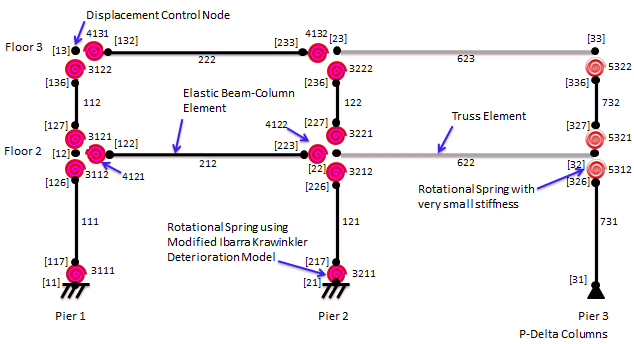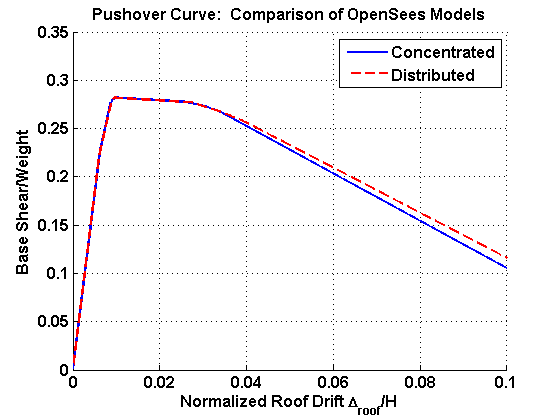File:Dynamic Analysis of 2-Story Moment Frame.doc
Dynamic_Analysis_of_2-Story_Moment_Frame.doc (file size: 40 KB, MIME type: application/zip)
Warning: This file type may contain malicious code. By executing it, your system may be compromised.
Example posted by: Laura Eads, Stanford University
This example demonstrates how to perform a dynamic analysis in OpenSees using a 2-story, 1-bay steel moment resisting frame. The structure is subjected to the Canoga Park record from the 1994 Northridge earthquake. The nonlinear behavior is represented using the concentrated plasticity concept with rotational springs. The rotational behavior of the plastic regions in both models follows a bilinear hysteretic response based on the Modified Ibarra Krawinkler Deterioration Model (Ibarra et al. 2005, Lignos and Krawinkler 2009, 2010). For this example, all modes of cyclic deterioration are neglected. A leaning column carrying gravity loads is linked to the frame to simulate P-Delta effects.
The files needed to analyze this structure in OpenSees are included here:
- The main file: dynamic_concentrated.tcl
Supporting procedure files
- DisplayModel2D.tcl – displays a 2D perspective of the model
- DisplayPlane.tcl – displays a plane in the model
- rotSpring2DModIKModel.tcl – creates a bilinear rotational spring that follows the Modified Ibarra Krawinkler Deterioration Model (used in the concentrated model)
- rotLeaningCol.tcl – creates a low-stiffness rotational spring used in a leaning column
All files are available in a compressed format here: dynamic_example.zip
The rest of this example describes the model and shows the analysis results.
Model Description

The 2-story, 1-bay steel moment resisting frame is modeled with elastic beam-column elements connected by zeroLength elements which serve as rotational springs to represent the structure’s nonlinear behavior. The springs follow a bilinear hysteretic response based on the Modified Ibarra Krawinkler Deterioration Model. A leaning column with gravity loads is linked to the frame by truss elements to simulate P-Delta effects. An idealized schematic of the model is presented in Figure 1. A leaning column with gravity loads is linked to the frame by truss elements to simulate P-Delta effects. To simplify this model, panel zone contributions are neglected and plastic hinges form at the beam-column joints, i.e., centerline dimensions are used. Subsequent examples will explicitly model the panel zone shear distortions and include reduced beam sections (RBS). The units of the model are kips, inches, and seconds. For a detailed description of this model, see Pushover Analysis of 2-Story Moment Frame.
Damping and the Rayleigh Command
This model uses Rayleigh damping which formulates the damping matrix as a linear combination of the mass matrix and stiffness matrix: ‘’’c’’’ = a0*’’’m’’’ + a1*’’’k’’’. A damping ratio of two percent, which is a typical value for steel buildings, is assigned to the first two modes of the structure. The rayleigh command allows the user to specify whether the initial, current, or last committed stiffness matrix is used in the damping formulation. In this example, only the initial stiffness matrix is used by assigning values of 0.0 to the other stiffness matrix coefficients. To properly model the structure, stiffness proportional damping is applied only to the frame elements and not to the highly rigid truss elements that link the frame and P-Delta columns, nor to the P-Delta columns themselves. OpenSees does not apply stiffness proportional damping to zeroLength elements. In order to apply damping to only certain elements, the rayleigh command is used in combination with the region command. As noted in the region command documentation, the region cannot be defined by BOTH elements and nodes. Because mass proportional damping assigns damping to nodes with mass, OpenSees will ignore any mass proportional damping that is assigned using the rayleigh command in combination with the region command for a region of elements. Therefore, if using the region command to assign damping, the mass proportional damping and stiffness proportional damping must be assigned in separate steps.
Modifications to the Stiffness Proportional Damping Coefficient
As described in the “Stiffness Modifications to Elastic Frame Elements” section of Pushover Analysis of 2-Story Moment Frame, the stiffness of the elastic frame elements has been modified. As explained in Ibarra and Krawinkler (2005) and Zareian and Medina (2010), the stiffness proportional damping coefficient that is used with these elements must also be modified. As the stiffness of the elastic elements was made “(n+1)/n” times greater than the stiffness of the actual frame member, the stiffness proportional damping coefficient of these elements must also be made “(n+1)/n” times greater than the traditional stiffness proportional damping coefficient.
Dynamic Analysis
This structure is subjected to the Canoga Park record from the 1994 Northridge earthquake.
Loading
Gravity loads are assigned to the beam-column joint nodes using the nodal load command. Gravity loads tributary to the frame members are assigned to the frame nodes while the remaining gravity loads are applied to the leaning columns. The gravity loads are applied as a plain load pattern with a constant time series since the gravity loads always act on the structure.
In this example, lateral loads are distributed to the frame using the methodology of ASCE 7-10 (http://www.asce.org/Product.aspx?id=2147487569). Lateral loads are applied to all the frame nodes in a given floor. A plain load pattern with a linear time series is used for lateral load application so that loads increase with time.
Recorders
The recorders used in this example include:
- The drift recorder to track the story and roof drift histories
- The node recorder to track the shear force reaction histories at the supports
- The element recorder to track the moment and rotation histories of the springs in the concentrated plasticity model
For the element recorder, the region command was used to assign all column springs to one group and all beam springs to a separate group.
It is important to note that the recorders only record information for analyze commands that are called after the recorder commands are called. In this example, the recorders are placed after the gravity analysis so that the steps of the gravity analysis do not appear in the output files.
Analysis
The structure is first analyzed under gravity loads before the dynamic analysis is conducted. The gravity loads are applied using a load-controlled static analysis with 10 steps. After this analysis is completed, the time is reset to zero so that the dynamic analysis starts from time zero. This is accomplished with the loadConst command.
The dynamic analysis is performed using a displacement-controlled static analysis. In this example, the structure was pushed to 10% roof drift, or 32.4”. The roof node at Pier 1, node 13 in Figures 1 and 2, was chosen as the control node where the displacement was monitored. Incremental displacement steps of 0.01” were used. This step size was used because it is small enough to capture the progression of hinge formation and generate a smooth backbone curve, but not too small that it makes the analysis time unreasonable.
Results

The results of the pushover analysis are shown in Figure 3. This figure shows the normalized base shear (weight of the structure divided by the base shear) versus the roof drift (roof displacement divided by the roof elevation). The models are nearly identical until about 2.5% roof drift when their curves begin to diverge. The descending branch of the the concentrated plasticity model is slightly steeper, but the two models agree reasonably well as there is less than 10% percent difference in the base shears at 10% roof drift.
References
- Ibarra, L. F., and Krawinkler, H. (2005). “Global collapse of frame structures under seismic excitations,” Technical Report 152, The John A. Blume Earthquake Engineering Research Center, Department of Civil Engineering, Stanford University, Stanford, CA. [electronic version: http://blume.stanford.edu/Blume/TRList.htm]
- Ibarra, L. F., Medina, R. A., and Krawinkler, H. (2005). “Hysteretic models that incorporate strength and stiffness deterioration,” Earthquake Engineering and Structural Dynamics, Vol. 34, 12, pp. 1489-1511.
- Lignos, D. G., and Krawinkler, H. (2009). “Sidesway Collapse of Deteriorating Structural Systems under Seismic Excitations,” Technical Report 172, The John A. Blume Earthquake Engineering Research Center, Department of Civil Engineering, Stanford University, Stanford, CA.
- Lignos, D. G., and Krawinkler, H. (2010). “Deterioration Modeling of Steel Beams and Columns in Support to Collapse Prediction of Steel Moment Frames,” ASCE, Journal of Structural Engineering (under review).
- Zareian, F. and Medina, R. A. (2010). “A practical method for proper modeling of structural damping in inelastic plane structural systems,” Computers & Structures, Vol. 88, 1-2, pp. 45-53.
File history
Click on a date/time to view the file as it appeared at that time.
| Date/Time | Dimensions | User | Comment | |
|---|---|---|---|---|
| current | 07:54, 2 September 2010 | (40 KB) | Leads (talk | contribs) |
You cannot overwrite this file.
File usage
There are no pages that use this file.